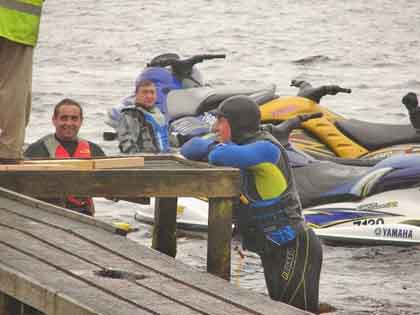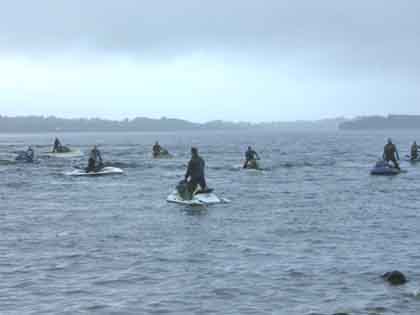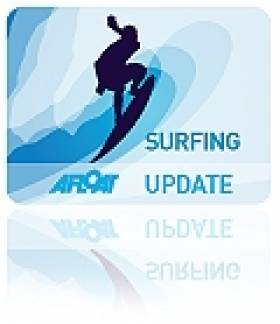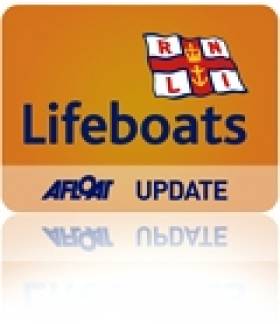Displaying items by tag: Jetski
The Wait Begins for Second Tow-In Surf Session
#SURFING - The waiting period for the second Tow-In Surf Session at Mullaghmore Head is now under way.
The invite-only list of the world's top big wave surfers has until 1 March 2012 to try to best the monster waves ridden in last February's inaugural contest.
Irish pioneers Richie Fitzgerald, Peter Conroy and Glyn Ovens will be on call for the return event, which has also invited back open teams winners Benjamin Sanchis and Éric Rebière, according to Surfworld Bundoran.
Sanchis is also the 2011 Billabong XXL biggest wave award winner, and intends to defend his crown in Sligo.
“Mullaghmore is a spectacular wave, but you really need to be prepared to surf big waves there," he said.
The first Tow-in Surf Session - which was even immortalised in a documentary - was organised by the Irish Surf Rescue Club in part to dispel the myth that tow-in surfing, where surfers are towed by jetski to bigger offshore waves, is an irresponsible activity.
“Our team has put an enormous amount of training, both here and abroad, to ensure that the sport of tow surfing and this event can be as safe as possible," said organiser Paul O'Kane.
The latest news on the second Tow-In Surf Session will be made available on the Billabong website HERE.
On Saturday July 2, Lough Derg RNLI Lifeboat launched, following a request by Valentia Coast Guard, to assist two persons on board a 22ft motor cruiser, that had suffered engine failure and was drifting close to rocks on the Urra shore. The Lifeboat with helm Eleanor Hooker, Ger Egan and Dom Sharkey on board, launched at 19.30hrs. Winds were southwesterly, Force 2. The lifeboat arrived on scene 19.35hrs. The two persons were safe and unharmed and both wearing life-jackets. The vessel was taken under tow, and tied safety alongside at the public harbour at Dromineer at 19.55hrs. The skipper of the vessel thanked the lifeboat crew and said that when he 'saw smoke coming from the engine, he had no option but to cut the power and call for help". He was reassured by the crew that he had done the right thing. The lifeboat returned to station and was ready for service again at 20.20hrs.
At 17.23hrs on Friday July 1, Lough Derg RNLI Lifeboat was requested to launch by Valentia Coast Guard, to assist two persons in difficulty in the water, after their jet ski failed close by the Scilly Islands, at the south-western end of Lough Derg. The Lifeboat with helm Peter Clarke, Eleanor Hooker and Ger Egan on board, launched at 17.35hrs. Soon after launching, the lifeboat was informed that a lakeboat was also going to the assistance of the persons in the water. The lifeboat arrived on scene 17.55hrs. The crew spoke to fishermen in the only lakeboat in the vicinity. The fishermen had no English but conveyed to the crew that they had taken the jet ski and the persons to a landing place on the Tipperary shore. Lifeboat crew searched the Tipperary shoreline indicated by the fishermen, including private harbours, but were unable to locate the jet-skiers or their jet-ski. The Coast Guard were unable to make contact with the person who had called in the request for help. The lifeoboat was stood down at 18.10hrs. The lifeboat returned to station and was ready for service again at 18.40hrsNorth West Personal Watercraft Club
North West Personal Watercraft Club
Our club was initially set up to save PWC users from being banned from a local lake. Now that we’ve successfully saved our lake we want to grow our club by increasing its members and arranging days out.
 Pictures from the Fun Day, 6th September, 2009
Pictures from the Fun Day, 6th September, 2009

We are a growing group of friendly, likeminded people that just want to have fun and be safe on a variety of personal privately owned watercrafts including boats, jetskis and standups.
The NWPWC website is a base for all things related to our club so please take some time to have a look around and feel free to get in contact and discuss becoming a member if you like what you see.
Our club is based in the North West of Ireland with committee and members from both sides of the border.
North West Personal Watercraft Club, 191 Melmount Road, Sion Mills, Co Tyrone BT82 9LA, N. Ireland. Email: [email protected]
or c/o Yel McClintock, Balliscadden, Coolboy, Letterkenny, Co Donegal. Fax: 0044 288 165 9111
Have we got your club details? Click here to get involved

























































